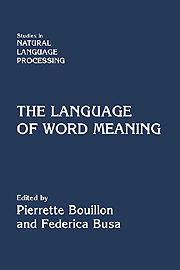Book contents
- Frontmatter
- Contents
- List of Contributors
- Preface
- Introduction: Word Meaning and Creativity
- Part I Linguistic Creativity and the Lexicon
- 1 Introduction
- 2 Chomsky on the Creative Aspect of Language Use and Its Implications for Lexical Semantic Studies
- 3 The Emptiness of the Lexicon: Critical Reflections on J. Pustejovsky's “The Generative Lexicon”
- 4 Generativity and Explanation in Semantics: A Reply to Fodor and Lepore
- 5 The “Fodor”-FODOR Fallacy Bites Back
- Part II The Syntax of Word Meaning
- Part III Interfacing the Lexicon
- Part IV Building Resources
- Index
4 - Generativity and Explanation in Semantics: A Reply to Fodor and Lepore
Published online by Cambridge University Press: 07 October 2011
- Frontmatter
- Contents
- List of Contributors
- Preface
- Introduction: Word Meaning and Creativity
- Part I Linguistic Creativity and the Lexicon
- 1 Introduction
- 2 Chomsky on the Creative Aspect of Language Use and Its Implications for Lexical Semantic Studies
- 3 The Emptiness of the Lexicon: Critical Reflections on J. Pustejovsky's “The Generative Lexicon”
- 4 Generativity and Explanation in Semantics: A Reply to Fodor and Lepore
- 5 The “Fodor”-FODOR Fallacy Bites Back
- Part II The Syntax of Word Meaning
- Part III Interfacing the Lexicon
- Part IV Building Resources
- Index
Summary
Abstract
In this article, I address the remarks made in Fodor and Lepore's article, “The Emptiness of the Lexicon: Critical Reflections on James Pustejovsky's The Generative Lexicon,” regarding the research program outlined in Pustejovsky (1995). My response focuses on two themes: Fodor and Lepore's misreadings and misinterpretations of the substance as well as the details of the theory, and the generally negative and unconstructive view of the study of semantics and natural language meaning inherent in their approach.
Methodological Preliminaries
I would like to address the remarks made in Fodor and Lepore's (henceforth, FL), “The Emptiness of the Lexicon: Critical Reflections on James Pustejovsky's The Generative Lexicon” (in this volume), regarding the research program outlined in Pustejovsky (1995). My response focuses on two themes: FL's misreadings and misinterpretations of the substance as well as the details of the book, and the generally misguided and unconstructive view of the study of semantics and natural language meaning inherent in their approach.
In contrast to this approach, I have proposed a framework, Generative Lexicon Theory, that faces the empirically hard problems of how words can have different meanings in different contexts, how new senses can emerge compositionally, and how semantic types predictably map to syntactic forms in language. The theory accomplishes this by means of a semantic typing system encoding generative factors, called “qualia structures,” into each lexical item. Operating over these structures are compositional rules incorporating specific devices for capturing the contextual determination of an expression's meaning.
- Type
- Chapter
- Information
- The Language of Word Meaning , pp. 51 - 74Publisher: Cambridge University PressPrint publication year: 2001
- 1
- Cited by



